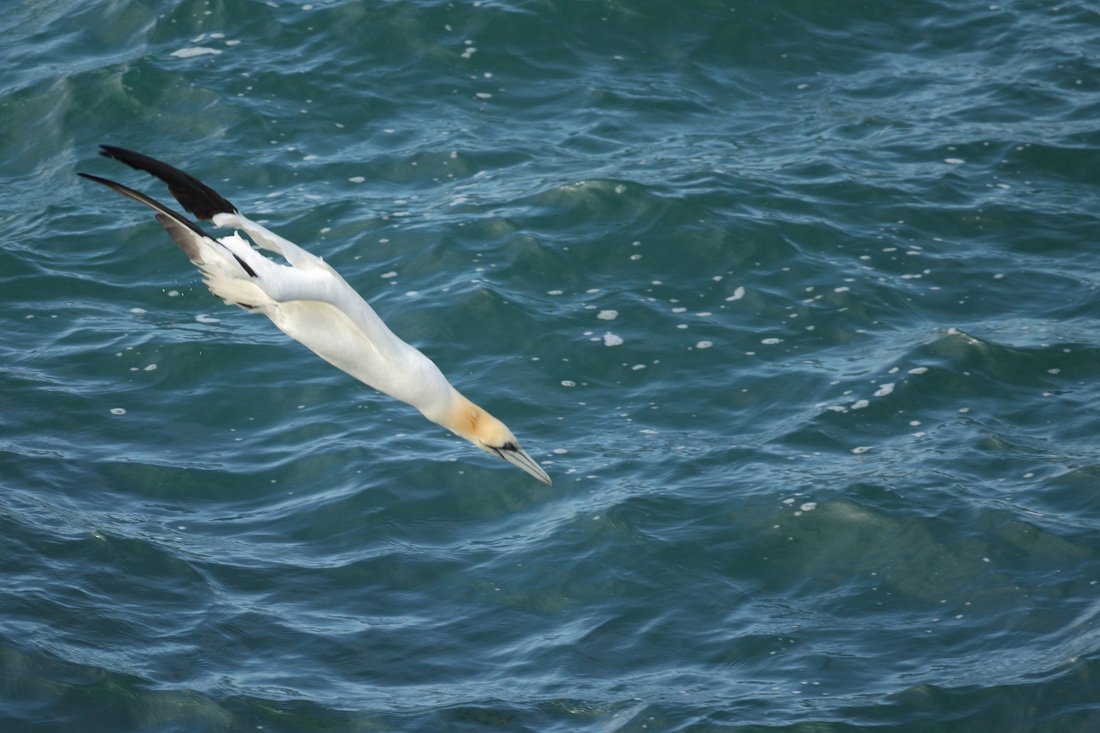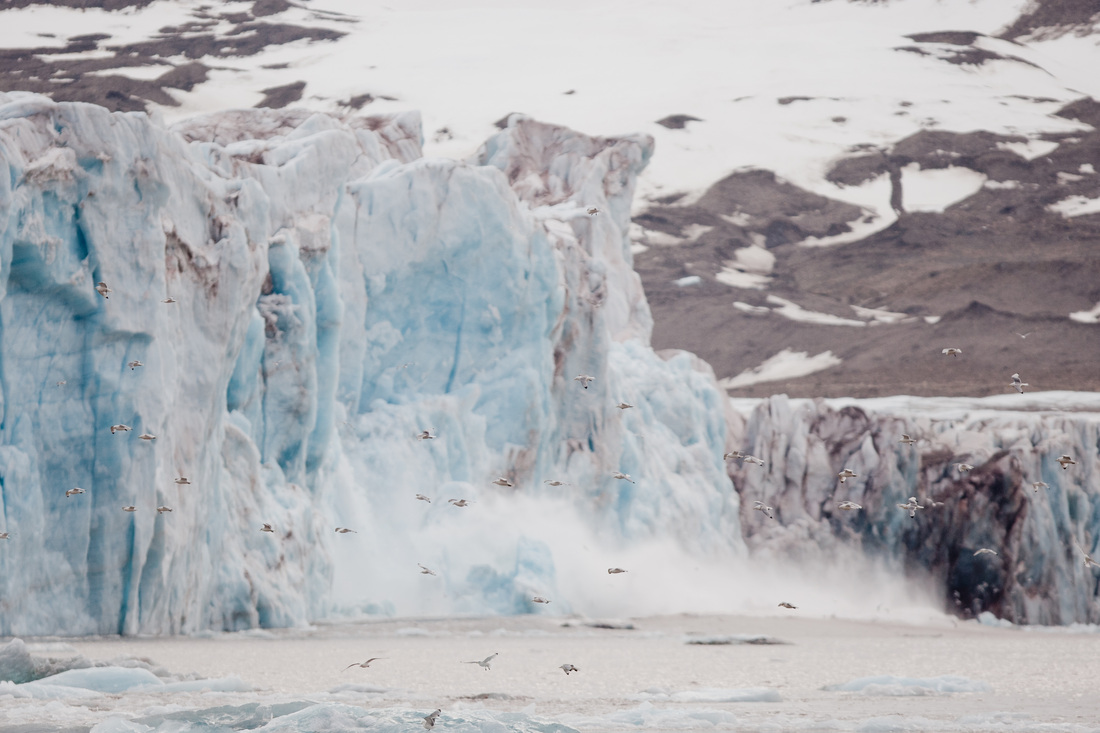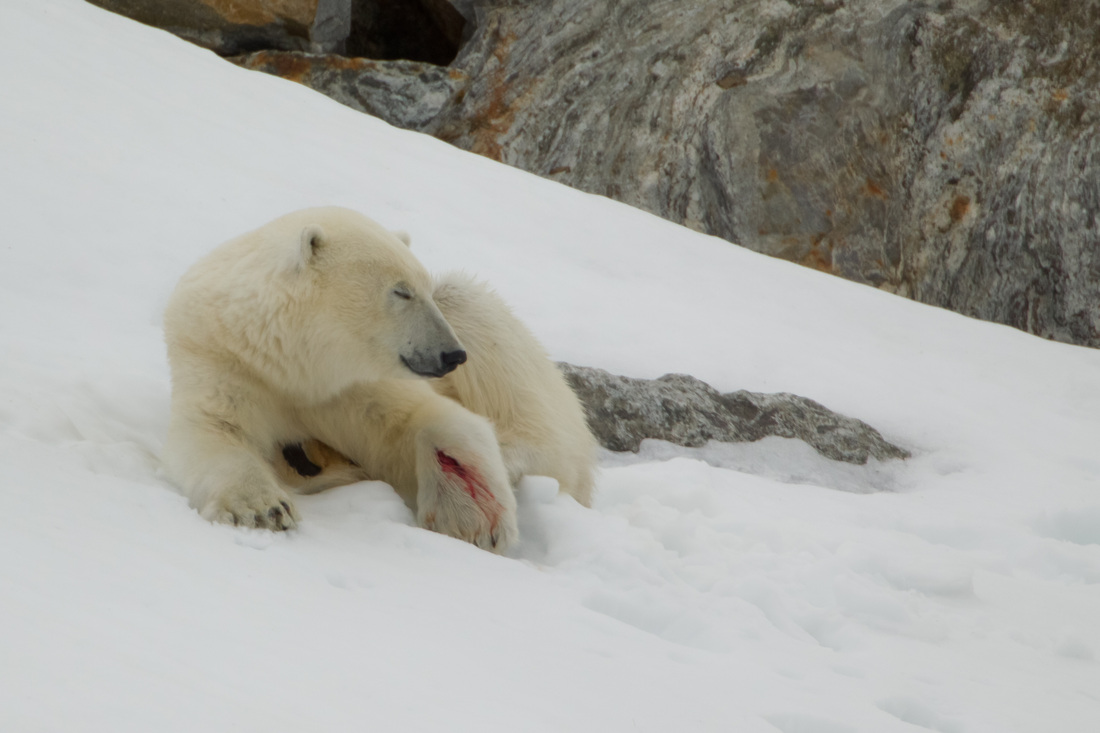|
8/5/2013 1 Comment Gannets of Great SalteeGreat Saltee Island is one of a pair of Islands located 3 to 4 miles off the Southern Coast of County Wexford in ireland. It is privately owned by the Neale family but unoccupied. Great Saltee is approximately 90 hectares in size and during May - September every year becomes the breeding home to around 3,000 pairs of Northern Gannets. There is of course alot of other Wildlife on the Islands where many migrants stop over such as Willow Warblers, Wheatear and Linnets but also the Island has a few Puffins, Razorbills, Guillemots and Shags. Gannets often stay together for many years but prior to breeding re-introduce themselves in a manner of ways the most common being 'billing' where they caress eachothers bills. Getting to know eachother is not done in private but in the relative safety of a colony. It is claimed that 70% of the worlds breeding Northern Gannets takes place on Ireland and UK shorelines so around 185,000 pairs across British and Irish coastlines. The majority of these pairs are found in Scotland and Scottish Isles but Saltee has 3,000 pairs. Gannets are protected in the UK even though their conservation status is 'least concern' and whilst localised predation can impact on the breeding numbers their biggest threat unsurprisingly is from man and over fishing mackerel and herring the Gannets preferred diet. The exception to this rule is in Ness where the inhabitants are permitted to cull 2,000 annually as the gannet is a local delicacy. Gannets breed at 5 years and can live to be 35 years old though generally likely age is 17 - 20 years. They lay 1 egg which is incubated for 4 - 5 weeks with young fledging at 12 weeks. Apart from Saltee gannets can be found in Faroe Islands, Iceland, Norway, Grassholm Wales, Bempton Northumberland, Shetlands, St Kilda Orkneys, Bass Rock Northumberland and Quebec canada. It is considered that the biggest single colony of Northern Gannets can be found on Bonnaventure Island Quebec estimated 60,000 pairs however St Kilda claims to have around 60,000 pairs with Bass Rock 50,000 pairs. Either way these 3 locations are home to 65% of the worlds breeding Northern Gannet. The Gannet has a wingspan of around 6 feet and is 3 foot in height. it catches fish by diving from upto 30 metres above the sea and spearing it prey with its specially adapted long bill. When diving the gannet can reach speeds of around 60mph so catching one in flight is not the easiest task however the gannet will often take its time and hover at great heights to identify the fish it will aim for When a particular fish has been identified the Gannet drops with great acceleration tucking its wings tightly into its body forming a spear shape As the Gannet hits the water at around 60 mph airbags around their neck and throat are deployed to absorb impact and whilst it is estimated they can reach depths of 15 metres the more regular diving depth is a shallow 5 - 7 metres. The Gannet is the largest sea bird in the UK, very friendly though noisy and should definitely be on any Bird Watchers list. Great Saltee off County Wexford is an awesome location, just head for Kilmore Quay and take a 15 minute boat trip to the Island where you land via zodiac. The hospitality is great, the Guiness is smooth the Island is free, you just have to pay for the boat trip and have a great time
1 Comment
27/7/2012 0 Comments Polar Bear Seal KillThe day had started well, great intentions to travel across the 80 degree line and up to the High North and pack ice where we hoped to find Polar Bears hunting Seals. The storms that had blighted most of this trip were so bad we turned around a little over 80 degrees (we did cross it but another blog) and headed back to Mushamna where we had anchored the night before. Mushamna was a quiet little cove protecting the boat from rough sea's and high winds but also offering a thin layer of ice that was breaking up and we had previous evening seen seals hauled sleeping. We had been sailing for 13 hours when we arrived back at Mushamna, tired disappointed and to be honest the group were for the first time not all at one because the turnaround was determined following a vote and majority decision. However that was about to be turned on its head because as we entered the security of the cove a Polar Bear was spotted on the ice and had spotted a single Seal laying a few feet from his water hole. I am not sure if the Seal was asleep or maybe distracted by the Boat but to witness this adult male Bear weighing maybe upwards of 500kg almost crawling along the ice toward the Seal was an experience I will never forget and ample evidence that you never know what will happen each day in the Arctic. The giant predator moved slowly toward the Seal, downwind so eliminating smell on the breeze but also taking advantage of the Seal's poor eyesight. The speed with which the Polar Bear suddenly accelerated was absolutely staggering and to see it up close was a truly unbelievable experience. Its a tough world and Polar Bears make many failed attempts however as you will see and sad as it may be to some on this occasion the Bear was successful. What happened next was as you can see quite amazing to see. With the Seal pinned down the Polar Bear stood over its prize, took a few moments to consider and then proceeded to lick the Seal before picking it up and killing it by thrashing it against the ice. The Polar Bear started to consume the Seal and was very quickly joined by Ivory and Glaucous Gulls. They say Ivory Gulls can smell and are happy to feed off blood and certainly they were the first birds on the scene to join the Bear in its feast. Once the Bear had eaten an amount it then took the remains of the Seal to the edge of the ice and washed them before then burying them. Having safely buried the Seal the Polar Bear then wandered around the ice a little before settling down and going to sleep enabling us to move a little closer with the Zodiacs before returning to our Boat. We had been back on the Boat for around an hour when a female Bear with a tracking tag turned up, seemed to know exactly where the Seal remains had been buried, dug them up and moved off. Polar Bears have an amazing sense of smell identifying food from many miles away and this female had done well to get around the sleeping male and try to steal his food. However the sleeping male awoke and refreshed from his snooze set about recovering his prize. The female is no match for a large male such as this Bear and she quickly dropped the Seal and moved away in search of other food. With the Seal safely recovered the male Bear again washed the Seal before eating almost the remainder in total. With very little left the bear buried what little remained before moving off. Before leaving the Bear went for a swim and having satisfied himself that the remains of his meal were safe, headed off in search of new food. As you will discover in my blog "playful young male" the remains did not stay safe for long as the next passer by a young male Polar Bear discovered the Seal.
7/7/2012 1 Comment Arctic Expedition 2012I left for the Arctic with a small group of like minded photographers on the 16th June. Flying from Heathrow to Oslo and then on to Longyearben in Svalbard where we were met by the Captain of our accommodation for the next 3 weeks. The Anne Margarithe is a 22m Sail Boat with a top speed of around 11 knots, has a Captain and 3 crew plus room for 10 very tightly packed passengers made more difficult because of all the Camera Equipment we had. It was an excellent form of travel for us to get into all those smaller places the bigger tankers could not get to, only downside was speed and at around 5 knots. We set sail on the 17th and having visited ymerbukta, trygghamna and poole-pynten we headed into Ny Alesund the worlds most Northern Town. Ny Alesund was very small, dated but had a little shop as you would expect for the tourists and a post office (last chance to send some hello's to the folks back home). One of the symbols of a time gone by in Ny Alesund was this old mining train Another symbol of Ny Alesund but also the symbol of Svalbard is the Ivory Gull (Pagophila eburnea). A medium sized gull easily recognised by its white plumage, black legs, yellow / orange tipped bill with an almost silver base and a black eye with a fine red rim. The bird is absolutely beautiful to see up close and whilst much of the surrounding areas of Ny Alesund are protected, whilst lying on the shingle on a section of the beach I fortunately had 2 birds become more inquisitive both of myself and the camera. Laying still for maybe 90 minutes trying to balance and manoeuvre a 500mm lens on the shingle was not easy but the images were worth it even if the light could have been brighter. Much of the wonder of the Arctic I have covered in other bloggs however having shared some history and beauty I would now like to highlight the plight of what is happening today in the Arctic. Every day the Glaciers break up and every day I either observed or heard huge pieces breaking away, pieces that will not anytime soon recover because our global temperatures are just too warm and these glaciers are left over from an age before humans. Apart from the temperature it is no exaggeration to reflect that the region is becoming a tip for all the waste and debris washed up on many shores from I was told Siberia. So serious is the situation that tourists are encouraged wherever possible to not only take all rubbish home (back to your boats) but under safe conditions spend one hour cleaning an area of beach so the rubbish can quickly be collected by the Sysselman. "Clean up Svalbard" is a collaboration between tourists, tour operators and the Governor of Svalbard to help protect and preserve this unique wilderness. Cultural artifacts are welcome but the impact of this debris on the Wildlife, particularly Polar Bears is not acceptable and within our gift to fix. I have many images evidence of the damage being done but the one I would like to share with you is this one with a Mother Bear feeding on a dead Walrus, her Cub (beautiful) is standing against her back but in this image you can clearly see the plastic and the wooden pallets around the Walrus. Its June, snowing gently but the ground around them is barren. Maybe not the image you might expect to see of a Polar Bear in the Arctic My saddest image was this one of a wounded Polar Bear. Initially the Bear looks like it might have been shot, possibly a warning shot but there are very strict rules in the Arctic and clear process to be adopted in the event you find yourself confronted by a Bear. Its also possible the Bear caught itself on rocks whilst scavenging for food either way a sad image. The sighting was reported to the Syssselman whom checked daily. Later on the trip we were told the Bear had moved away presumed suitably healed. My final image in this blog is one I have and will use a number of times as it is one of my favourites, the Polar Bear is stunning, has found a nice bit of ice to walk on against a shingle shore but the most striking element of this image is the heat haze clearly visible behind the Bear. Temperature outside was around zero it was late june and the last time I saw haze like this was off the pipes of a motorbike during Superbikes GP Silverstone.
|
John BettsWildlife Photographer ArchivesCategoriesAll 300mm Lens 500mm Lens Anne Margarithe Arctic Bear Tracker Billing Canon Camera Colonies Heathrow Ivory Gull Longyearben Ny Alesund Oslo Polar Bear Sail Boat Seal Siberia Svalbard Swimming Sysselman Wounded |
- Home
- About
- Blog
- Black & White Gallery
- Image of the Month
-
Expeditions Gallery
- Arctic 2012
- Cayman Islands 2012
- Scotland 2012
- Scotland 2013
- Skomer 2013
- Great Saltee 2013
- Great Saltee 2014
- Scotland 2014
- Japan 2014 >
- Yellowstone Park 2015 >
- Scotland 2015 >
- Africa 2015 >
- Falklands 2015 >
- South Georgia 2015 >
- Dovrefjell. Norway
- Iceland 2016 >
- Melrakki - Iceland
- Puffins of Skomer Island 2017
- Golden Eagles of Sweeden
- Shetland Islands 2017
- Antarctica - The Last Frontier
- Big Cats and wildlife of Tanzania
- Masterclass
- Bird ID Help
- Fine Art prints
- Contact
- Shop
- Home
- About
- Blog
- Black & White Gallery
- Image of the Month
-
Expeditions Gallery
- Arctic 2012
- Cayman Islands 2012
- Scotland 2012
- Scotland 2013
- Skomer 2013
- Great Saltee 2013
- Great Saltee 2014
- Scotland 2014
- Japan 2014 >
- Yellowstone Park 2015 >
- Scotland 2015 >
- Africa 2015 >
- Falklands 2015 >
- South Georgia 2015 >
- Dovrefjell. Norway
- Iceland 2016 >
- Melrakki - Iceland
- Puffins of Skomer Island 2017
- Golden Eagles of Sweeden
- Shetland Islands 2017
- Antarctica - The Last Frontier
- Big Cats and wildlife of Tanzania
- Masterclass
- Bird ID Help
- Fine Art prints
- Contact
- Shop
Search by typing & pressing enter

























 RSS Feed
RSS Feed